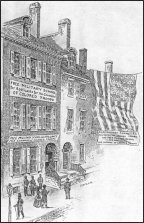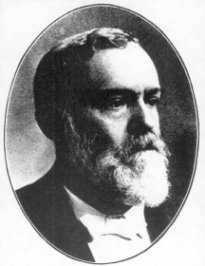Who They Were…What They Did
The Bureau of Colored Troops
 White officers for the colored troops were selected with great care, generally from regiments of white troops in the field. The committee for the supervision of recruiting of colored regiments opened a school of instruction at 1210 Chestnut Street in Philadelphia, where under the direction of Major George A. Hearns, U.S.A. Commissioner, Colonel John H. Taggart (late an officer of the 12th Regiment, Veteran Reserve Corps), instructed applicants for commissions.
White officers for the colored troops were selected with great care, generally from regiments of white troops in the field. The committee for the supervision of recruiting of colored regiments opened a school of instruction at 1210 Chestnut Street in Philadelphia, where under the direction of Major George A. Hearns, U.S.A. Commissioner, Colonel John H. Taggart (late an officer of the 12th Regiment, Veteran Reserve Corps), instructed applicants for commissions.
|
|
On October 3rd, 1863, the 6th Regiment and four companies of the 8th Regiment, colored troops were paraded in the city under the command of Colonel John W. Ames, and escorted by Lieutenant Colonel Louis Wagner and staff. Lieut. Col. Wagner, later to be promoted to General, was the commander of Camp William Penn. (click image to the left for larger view)
These regiments were reviewed at the Union League Club and provided with a dinner at the Union Volunteer Refreshment Saloon. The soldierly bearing of these troops was widely reported in the newspapers and won for them great praise and admiration from the press and the public. For the assistance of these volunteer troops, the Colored Women’s Sanitary Commission was formed, with headquarters at 404 Walnut Street in Philadelphia. The officers of this commission are reported as Mrs. Caroline Johnson, President; Mrs. Arena Ruffin, Vice-President; Reverend Stephen Smith, Treasurer; Reverend J. Asher, Secretary.
“The colored regiments mustered at Camp William Penn were numbered the 3rd, 6th, 8th, 22nd, 24th, 25th, 32nd, 41st, 43rd, 45th, and 127th, and as they were not rated as part of the regular force of the United States Army, they were not credited upon the quota of Philadelphia or of the State of Pennsylvania.
The records for bravery under fire and efficiency in the campaigns in which they were employed, to the credit of the colored soldiers in the Union Army, were shared by the ten thousand nine hundred and forty rank and file and nearly four hundred white officers commanding them, all of whom were originally assembled at Camp William Penn.
Upon a pillar of the Court of Honor erected in honor of the 33rd Annual National Encampment of the Grand Army of the Republic, September 4th to 9th, 1899 was inscribed the name, for distinguished heroism, of Serg. Arthur Harold of Company A, 8th Regiment, United States Colored Troops, who was killed at Peterburg.”
(PREAMBLE AND RESOLUTIONS UNANIMOUSLY ADOPTED AT THE THIRTY-THIRD NATIONAL ENCAMPMENT OF THE GRAND ARMY OF THE REPUBLIC, HELD IN THE CITY OF PHILADELPHIA, SEPTEMBER 6 AND 7,1899.)
Whereas the first efforts ever made to preserve and fully mark a battlefield were begun in 1863, immediately after the battle of Gettysburg, to preserve the features of that field and to mark the positions and movements of the troops engaged; this was done by loyal hearts and willing hands at a cost of over $2,000,000, and without any help from Congress; and
Whereas all this property was transferred to the General Government in 1895 free of cost, and in view of the liberal contributions by States, by societies, and by individuals, there should be more liberal appropriations on the part of Congress to complete this work on the field where the greatest battle of the war was fought one of the greatest battles of modern times:
Therefore, Resolved, That we earnestly commend the Gettysburg National Military Park Commission in its work of acquiring lands of historical interest, of constructing avenues along lines of battle otherwise inaccessible, in restoring and preserving the original features of the field and in marking with tablets and monuments the positions and movements of troops, so that the history of the battle will practically be written on the field; and
Resolved, That we ask Congress to make liberal appropriations to enable the commissioners to acquire the necessary lands and complete at an early day the work provided for by the act creating the park.
ALBERT D. SHAW
Commander in Chief.
THOMAS J. STEWART,
Adjutant-General.)
Siege of Petersburg http://members.aol.com/siege1864
